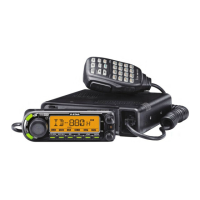22
REPEATER OPERATION
3
N General
Repeaters allow you to extend the operational range of your
radio because a repeater has much higher output power than
the typical transceiver.
Usually, a repeater has independent frequencies for receive
and transmit. The repeater may also require a subaudible
tone for access.
Reference amateur radio handbooks and local ham maga-
zines for details of local repeaters such as repeater input/out-
put frequencies and locations.
Repeater example;
Receives the 434.540 MHz signal
and the detected audio signals are
transmitted on 439.540 MHz
simultaneously.
Station A:
Tx: 434.540 MHz
Rx: 439.540 MHz
Station B:
Tx: 434.540 MHz
Rx: 439.540 MHz
• Repeater operation flow chart
Step 3:
Set the duplex (shift) direction (– duplex or +duplex).
- Set the offset frequency (amount of shift), if required.
Step 4:
Set the subaudible tone (repeater tone) encoder function ON.
- Set the subaudible tone frequency, if required.
Step 1:
Set the desired band to operate the repeater.
Step 2:
Set the desired receive frequency (repeater output frequency).
• Repeater settings can be stored into a memory channel.

